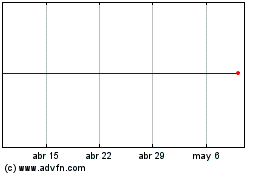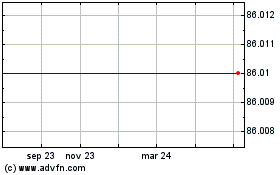Honeywell, Rival Diverge Over Prospects Of Tie-Up
24 Febrero 2016 - 2:02AM
Noticias Dow Jones
(FROM THE WALL STREET JOURNAL 2/24/16)
By Ted Mann and Jon Ostrower
Honeywell International Inc. kept the pressure on rival United
Technologies Corp. to engage in merger talks, saying there were no
major regulatory obstacles to a combination of the two industrial
conglomerates.
"We do not see the regulatory process as a material obstacle to
a transaction," Honeywell said Tuesday. It said the proposed
combination would create $3.5 billion in savings and benefit
customers, but offered a reassurance to its own shareholders that
it wouldn't overpay to get its rival to the negotiating table.
"We would not and will not pursue a transaction that is not in
the best interest of our shareowners," Honeywell said.
Honeywell's persistence comes amid sharply divergent visions of
whether regulators would allow two major players in the
increasingly consolidated aerospace industry to join together. In
some cases, such a merger would leave just one supplier for crucial
aircraft parts and systems.
United Technologies said the Honeywell proposal was dead on
arrival because of the likely objections of major customers -- such
as plane makers Boeing Co. and Airbus Group SE -- as well as
regulators on three continents. Each also is a major supplier to
the U.S. military.
"It ain't going to happen," Chief Executive Gregory Hayes said
Tuesday in an appearance on CNBC. "There is just no way to get it
done."
The industrial giants, which have a combined $95 billion in
annual revenue, share an extended list of overlapping aerospace
products that range from environmental-control systems for planes
to engines that power business jets and military helicopters.
Boeing and Airbus account for about $10 billion worth of annual
revenue at United Technologies. Airbus alone represents about 40%
of sales at the company's Pratt & Whitney jet engine
business.
In recent years, the big aircraft makers have sought to regain
control and leverage by shifting some work to smaller suppliers,
said Kevin Michaels, vice president with ICF International's
aerospace-consulting practice. For example, Boeing on its coming
777X jetliner selected a small Canadian firm to provide the landing
gear, unseating United Technologies, a move seen by industry
officials as part of Boeing's effort to renegotiate its contracts
with the industrial giant.
"Honeywell and UTC were right in the bull's-eye" for Boeing's
cost-cutting initiative, and with a potential merger "you've
created another concentric ring inside the bull's-eye," said Mr.
Michaels.
When United Technologies recently disclosed the merger proposal
to top-ranking executives at some of its biggest customers, the
reaction was "a violent 'No,' " one person familiar with the
company's thinking said.
But people familiar with Honeywell's thinking reject the
argument that antitrust approval would be as difficult to obtain as
Mr. Hayes suggests. Honeywell estimates the companies would have to
review business lines worth about $4 billion on antitrust grounds,
and that ultimately it would have to divest businesses worth less
than 4% of United Technologies' annual sales, or about $2 billion
in sales.
United Technologies estimates the divestitures would total $9
billion to $10 billion, according to another person familiar with
the company's thinking, and would require disruptive efforts to
shed some product lines while retaining others.
After months of on-and-off discussions, on Friday Honeywell CEO
David Cote met in person with Mr. Hayes and United Technologies'
board chairman, Edward Kangas, and presented his plan to combine
the two companies, according to people familiar with the matter.
Honeywell was offering to pay $108 a share for United
Technologies.
The deal would have made Mr. Cote, 63 years old, CEO of the new
entity, while creating an important but unspecified role for Mr.
Hayes, 55, one of the people said.
(END) Dow Jones Newswires
February 24, 2016 02:47 ET (07:47 GMT)
Copyright (c) 2016 Dow Jones & Company, Inc.
United Technologies (NYSE:UTX)
Gráfica de Acción Histórica
De Jun 2024 a Jul 2024

United Technologies (NYSE:UTX)
Gráfica de Acción Histórica
De Jul 2023 a Jul 2024
